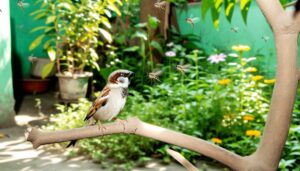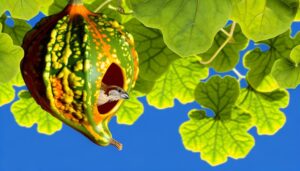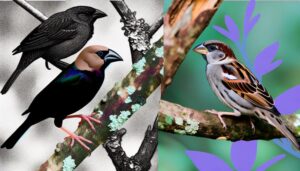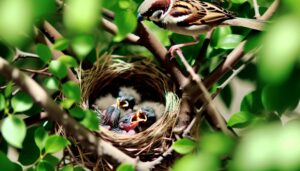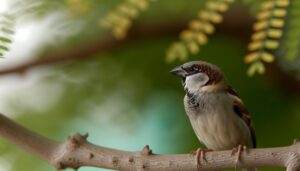3 Simple Steps to Get Rid of House Sparrows in Your Australian Home
Effectively managing House Sparrows in Australia involves multiple strategies. Begin with nest identification, focusing on dome-shaped structures often found in man-made areas.
Control food sources by securing garbage bins and promptly cleaning spills. Install bird netting with mesh sizes under 20mm and use sparrow traps baited with cracked corn or millet.
Visual deterrents like reflective tape or predatory bird decoys can disrupt sparrow behavior. Seal entry points using materials such as metal mesh and engage natural predators like hawks.
Regularly inspect nests to maintain control. For a thorough understanding of successful sparrow management, explore further.
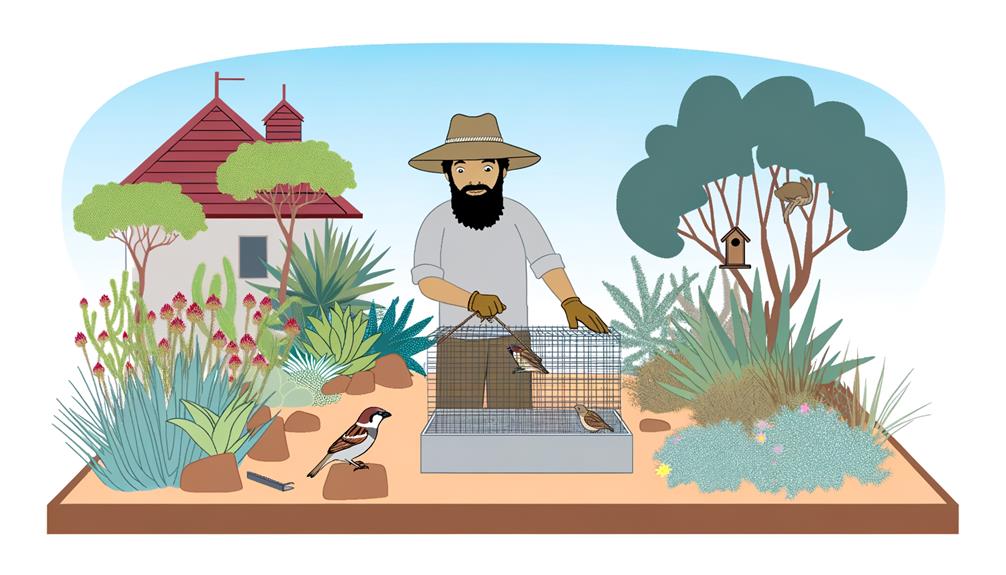
Key Takeaways
- Remove Food Sources: Secure garbage bins and promptly clean spilled birdseed or pet food to reduce sparrow food supply.
- Install Bird Netting: Use UV-stabilized netting with mesh smaller than 20mm to prevent sparrow access to nesting sites.
- Use Sparrow Traps: Implement funnel or repeating traps baited with cracked corn or millet, and monitor them regularly.
- Seal Entry Points: Close gaps in eaves and other small openings with materials like metal mesh and caulking to prevent sparrow entry.
- Implement Visual Deterrents: Utilize reflective tape, predatory bird decoys, and holographic devices to create an environment perceived as unsafe by sparrows.
Identify House Sparrow Nests
House Sparrow nests are typically identified by their dome-shaped structure, constructed from coarse grasses, and lined with feathers or soft materials. These nests are often found in man-made structures such as eaves, gutters, and cavities in buildings.
Observations indicate that the nests are strategically placed to provide shelter from predators and environmental elements. Additionally, House Sparrows may also incorporate twigs, paper, and other available debris into their nests, creating a robust and insulated environment for their offspring.
The presence of droppings and frequent sparrow activity around these nests can further aid in identification. By understanding the specific architectural features and common locations of House Sparrow nests, one can effectively discern their presence and take appropriate measures for control.
Remove Food Sources
Eliminating accessible food sources is a critical strategy in the control and reduction of House Sparrow populations in urban environments. House Sparrows thrive in areas where food is readily available. Ensuring that food waste is properly managed is paramount.
Secure garbage bins with tight-fitting lids to prevent access, and clean up any spilled birdseed or pet food promptly. Additionally, consider removing or modifying bird feeders that attract sparrows, opting for feeders designed to accommodate native bird species instead.
Implementing these measures reduces the nutritional resources available to sparrows, subsequently limiting their breeding success and population growth. Evidence suggests that habitats with reduced food availability experience lower sparrow densities, contributing to a more balanced urban ecosystem.
Install Bird Netting
Installing bird netting is an efficient method to prevent House Sparrows from accessing areas where they can roost, nest, or cause damage. This technique involves strategically placing a barrier to create an impenetrable zone, thereby mitigating sparrow-related issues. Evidence suggests that bird netting reduces sparrow activity by limiting their entry points.
Detailed observations indicate the necessity of employing high-quality, UV-stabilized netting for durability.
To achieve optimal results, consider the following steps:
- Measure the Area: Accurately measure the dimensions of the targeted space to ensure proper coverage.
- Select Appropriate Netting: Choose netting with a mesh size smaller than 20mm to effectively exclude sparrows.
- Secure the Netting: Utilize sturdy fasteners to attach the netting securely.
- Regular Inspections: Periodically examine and maintain the netting to prevent gaps or sagging.
Use Sparrow Traps
In addition to physical barriers like bird netting, using sparrow traps can effectively manage and reduce the population of House Sparrows in targeted areas.
Sparrow traps, such as funnel traps and repeating traps, have been scientifically shown to capture these invasive birds efficiently. According to studies, the strategic placement of traps near feeding areas and nesting sites increases capture rates significantly.
It is important to use bait that is highly attractive to sparrows, such as cracked corn or millet, to enhance the efficacy of the traps. Regular monitoring and maintenance of traps are vital to make sure humane treatment and compliance with wildlife regulations.
Employing sparrow traps as part of an integrated pest management approach can yield substantial results in controlling sparrow populations.
Implement Visual Deterrents
Utilizing visual deterrents can disrupt the behavior patterns of House Sparrows, thereby reducing their presence in specific areas. Visual deterrents rely on sparrows' natural aversion to certain stimuli. Based on empirical observations, the following items have proven effective:
- Reflective tape: Strips of reflective tape can mimic the sunlight and create visual disturbances that sparrows find unsettling.
- Predatory bird decoys: Models of raptors, such as hawks or owls, can induce a fear response in sparrows, deterring them from settling.
- Mylar balloons: The movement and reflective nature of these balloons can create an environment perceived as unsafe by sparrows.
- Holographic devices: These devices use light-scattering properties to generate unpredictable visual patterns that disrupt sparrow activity.
Implementing these strategies can significantly curtail sparrow habitation.
Seal Entry Points
Effectively managing House Sparrow populations requires identifying and sealing potential entry points to prevent their access to nesting and roosting sites.
Detailed observations show that sparrows often exploit small openings, like gaps in eaves, vents, and soffits, to build nests. Using materials such as metal mesh, caulking, and weatherstripping can efficiently seal these entry points.
Evidence-based research indicates that a thorough inspection of structures to locate and close these gaps greatly reduces sparrow occupancy. Moreover, bird exclusion netting can act as a deterrent for larger openings.
Regular maintenance and monitoring are essential to make sure that new entry points do not develop over time, thus maintaining the effectiveness of these preventive measures.
Encourage Natural Predators
Promoting the presence of predatory birds such as hawks and owls can greatly reduce house sparrow populations through natural predation.
Additionally, the introduction of beneficial insects, like ladybugs and wasps, can help control sparrow numbers by competing for similar food sources.
Empirical studies have shown that these ecological interventions can create a balanced ecosystem, thereby mitigating the proliferation of invasive house sparrows.
Attract Predatory Birds
Introducing natural predators such as hawks, owls, and kestrels into areas with high house sparrow populations can reduce their numbers through predation. These avian predators play a pivotal role in maintaining ecological balance by controlling pest bird species. Evidence-based observations indicate that fostering an environment conducive to these predators can be achieved through several strategies:
- Habitat Enhancement: Incorporate native trees and shrubs that provide suitable nesting sites and perches.
- Artificial Nesting Boxes: Install boxes designed specifically for predatory birds to encourage their presence.
- Minimize Disturbances: Reduce human activities that may deter predatory birds from settling in the area.
- Supplemental Feeding: Provide food sources to support the initial attraction and establishment of predatory birds.
Implementing these measures can effectively harness natural predatory behaviors to manage house sparrow populations.
Introduce Beneficial Insects
Encouraging the presence of beneficial insects such as ladybugs, lacewings, and parasitic wasps can help control house sparrow populations by naturally reducing their food sources. These insects prey on aphids, caterpillars, and other small pests that constitute a significant portion of the house sparrow diet.
Scientific studies have shown that increasing the population of these predatory insects can lead to a marked decrease in pest populations, thereby limiting the availability of food for house sparrows. Detailed observations indicate that introducing these beneficial insects into garden ecosystems can create a balanced environment where natural predators keep pest populations in check.
This method offers an environmentally friendly and sustainable approach to managing house sparrow numbers without resorting to harmful chemicals.
Monitor and Maintain
Effective management of house sparrow populations necessitates regular nest inspections to identify and eliminate potential breeding sites.
Concurrently, consistent control of food supply sources is critical to reducing the attractiveness of the environment to these invasive birds.
Evidence-based practices indicate that these combined strategies notably mitigate the proliferation of house sparrows in targeted areas.
Regular Nest Inspections
Regular nest inspections are crucial for monitoring and maintaining the population control of house sparrows in Australia. They enable the timely identification and removal of active nests, helping to mitigate potential infestations and prevent breeding cycles from establishing. Conducting regular inspections can help in guaranteeing prompt action to control the population. Key steps include:
- Identify Nesting Sites: Focus on common nesting locations such as eaves, gutters, and crevices.
- Schedule Inspections: Perform inspections bi-weekly during the breeding season to guarantee prompt action.
- Record Observations: Maintain detailed logs of nest locations, activity levels, and removal dates.
- Use Appropriate Tools: Employ ladders, binoculars, and protective gloves to safely inspect and handle nests.
These practices are supported by scientific findings, highlighting their effectiveness in controlling house sparrow populations.
Consistent Food Supply Control
How does regulating the availability of food sources impact the control of house sparrow populations in Australia?
Controlling food supply is pivotal in managing house sparrow populations, as these birds thrive in environments with abundant sustenance. Evidence indicates that consistent monitoring and reduction of accessible food sources, such as seeds, grains, and food waste, can diminish sparrow numbers.
Detailed observations reveal that sparrows are less likely to inhabit areas where food is scarce, thereby reducing breeding opportunities. This is particularly effective when combined with other control measures like habitat modification.
Implementing secure storage of food products and regularly cleaning feeding areas can disrupt their food supply, leading to a natural decline in their population without resorting to harmful eradication methods.
Conclusion
The eradication of house sparrows in Australia requires an orchestrated symphony of careful strategies. This includes identifying nests, removing food sources, installing bird netting, utilizing sparrow traps, deploying visual deterrents, sealing entry points, and promoting natural predators.
The precise implementation of these methods, underpinned by rigorous monitoring and maintenance, guarantees unparalleled effectiveness. The meticulous execution of these scientifically validated techniques promises not just a reduction but an absolute cessation of house sparrow infestations, transforming urban and rural landscapes into avian-free sanctuaries.

